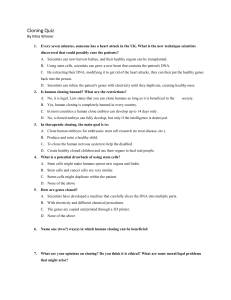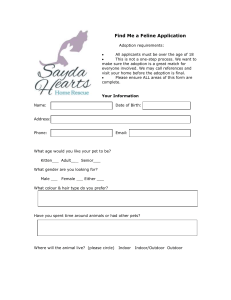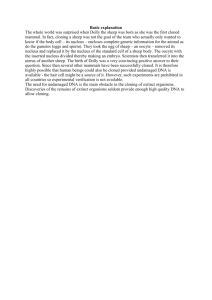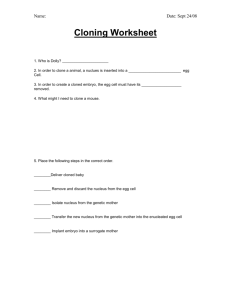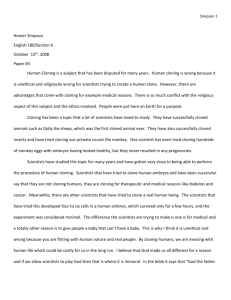Animals and People
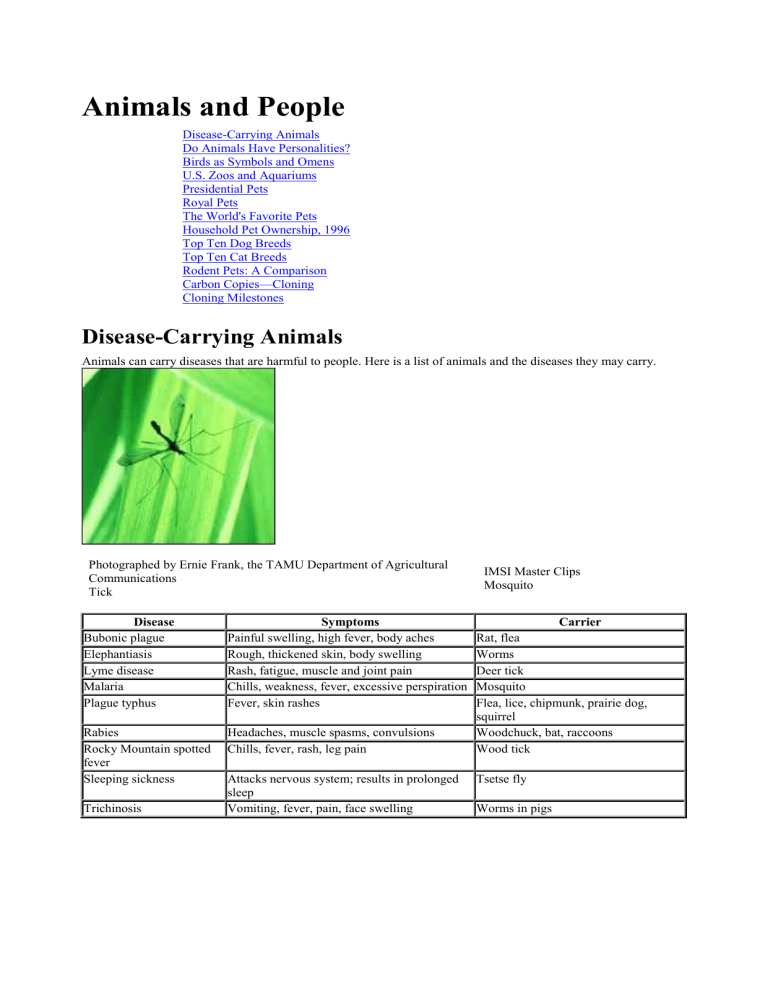
Animals and People
Disease-Carrying Animals
Do Animals Have Personalities?
Birds as Symbols and Omens
U.S. Zoos and Aquariums
Presidential Pets
Royal Pets
The World's Favorite Pets
Household Pet Ownership, 1996
Top Ten Dog Breeds
Top Ten Cat Breeds
Rodent Pets: A Comparison
Carbon Copies—Cloning
Cloning Milestones
Disease-Carrying Animals
Animals can carry diseases that are harmful to people. Here is a list of animals and the diseases they may carry.
Photographed by Ernie Frank, the TAMU Department of Agricultural
Communications
Tick
Disease
Bubonic plague
Elephantiasis
Symptoms
Painful swelling, high fever, body aches
Rough, thickened skin, body swelling
Lyme disease
Malaria
Plague typhus
Rash, fatigue, muscle and joint pain
IMSI Master Clips
Mosquito
Rat, flea
Worms
Chills, weakness, fever, excessive perspiration Mosquito
Fever, skin rashes
Deer tick
Carrier
Flea, lice, chipmunk, prairie dog, squirrel
Rabies
Rocky Mountain spotted fever
Sleeping sickness
Headaches, muscle spasms, convulsions
Chills, fever, rash, leg pain
Woodchuck, bat, raccoons
Wood tick
Tsetse fly Attacks nervous system; results in prolonged sleep
Vomiting, fever, pain, face swelling Worms in pigs Trichinosis
Do Animals Have Personalities?
We don't know whether animals insult their enemies by calling them human beings, but we call on quite a few animals to describe other people in uncomplimentary ways. Here are some animals that seem to embody less desirable human characteristics.
Bats: To call someone “batty” or say a person has “bats in the belfry” is to call the person crazy. When a ringing church bell disturbs bats who live in a belfry (the tower where a church bell is rung), they fly around in a frenzied way. The belfry is seen as a person's head; the disordered movements of the bats are his or her thoughts.
Birdbrain: A stupid person is often called a birdbrain since a bird's brain is normally small—about the size of the bird's eye.
Jellyfish: A person who has a weak character is called a jellyfish, because jellyfish have no spines (they can't stand up straight) and are composed of water and a jellylike substance (soft, wobbly, and insubstantial).
Leech: A person who attaches himself or herself to another and takes without giving anything in return is often called a leech, since a leech is a blood-sucking worm.
Lone wolf: Someone who is described as a lone wolf is an outsider, one who keeps to himself or herself. Since, like people, most wolves live in families and travel in packs, a single wolf is unusual and has either strayed from the pack or been driven away.
Pig: A sloppy or messy person is often called a pig, for pigs often wallow in the mud or dust in order to keep cool.
Birds as Symbols and Omens
From ancient times to the present, certain birds have been considered both symbols and forecasters of events. These eight birds, from every part of the world, have been especially important.
Cranes are revered in Asia as symbols of long life.
IMSI Master Clips
Cuckoos are welcomed as a sign of spring in Europe and are considered omens of a happy marriage.
Doves symbolize love and peace. To dream of doves means happiness is at hand.
arttoday.com
Eagles are considered sacred by Native Americans. The claws and bones of the birds are believed to drive illness away. As the symbol of the U.S., the bald eagle stands for endurance, independence, and courage.
IMSI Master Clips
Owls are considered prophets of doom. In ancient Rome as well as modern European and American folklore, a hooting owl warns of death.
IMSI Master Clips
The phoenix is a mythical bird that dies by fire, then rises from its own ashes after 500 years! Thus it symbolizes renewed life.
Ravens are said to predict death and pestilence (disease). Folklore has it that the raven's sense of smell is so acute that it can smell death before it comes. No one wanted to see a raven fly over a house!
Storks are symbols of good luck. In folklore, storks deliver babies. arttoday.com
Presidential Pets
U.S. presidents and their families have typically liked animals. Creatures from mice to bears have made a home at the White House and its grounds. The following list of presidential pets is not complete, however, as no doubt many a presidential cat or cow passed through without much public notice.
Library of Congress
President Harding with his dog
Laddie
Animals
Polly the parrot; 36 hounds; horses
President
George
Washington
John Adams horses
Thomas
Jefferson a mockingbird; two bear cubs, a gift from Lewis and Clark
James Madison Macaw the parrot; sheep
James Monroe a spaniel
John Quincy
Adams an alligator; silkworms
Andrew
Jackson
Martin Van
Buren horses named Truxton, Sam Patches, Emily, Lady Nashville, and Bolivia; Pol the parrot; ponies two tiger cubs
William Henry a goat; a cow
Harrison
John Tyler
James Knox
Polk
Le Beau, a greyhound; a horse named The General a horse
Zachary Taylor Old Whitey the horse
Millard
Fillmore no pets
Franklin Pierce no pets
James
Buchanan
Lara, a Newfoundland; an eagle; an elephant
Abraham
Lincoln
Andrew
Johnson
Ulysses S.
Jack the turkey; goats named Nanny and Nanko; ponies; cats; dogs; pigs; a white rabbit white mice
Faithful, a Newfoundland; horses named Jeff Davis, Julia, Jennie, Mary, Butcher Boy, Cincinnatus,
Grant Egypt, and St. Louis; ponies named Reb and Billy Button; pigs; dogs; a parrot; roosters
Rutherford B.
Hayes
Siam, a Siamese cat; Grim, a greyhound; Duke, an English mastiff; Hector, a Newfoundland; Dot, a terrier; canaries; cows; horses; goats; other dogs
James Garfield Kit the horse; Veto the dog; fish no pets Chester Alan
Arthur
Grover
Cleveland a poodle; canaries and mockingbirds
Benjamin
Harrison
William
McKinley
Dash the dog; Whiskers the goat; dogs; an opossum a parrot; an Angora cat and her kittens
Theodore
Roosevelt
Sailor Boy, a Chesapeake Bay retriever; Manchu, a Pekingese; Skip, a mutt; terriers named Jack and Pete; cats named Tom Quartz and Slippers; Josiah the badger; Algonquin the pony; Eli the macaw; Jonathan the piebald rat; Emily Spinach, a garter snake; twelve horses; five bears; five guinea pigs; other snakes; two kangaroo rats; lizards; roosters; an owl; a flying squirrel; a raccoon; a coyote; a lion; a hyena; a zebra
William Taft Pauline Wayne the cow
Old Ike the ram; sheep; chickens; cats Woodrow
Wilson
Warren
Harding
Laddie Boy, an Airedale; Old Boy, a bulldog; canaries
Calvin
Coolidge
Herbert
Hoover
Peter Pan, a terrier; Paul Pry (née Laddie Buck), an Airedale; Calamity Jane, a sheepdog; Boston
Beans, a bulldog; King Cole, a shepherd; Palo Alto, a birder; collies named Rob Roy (née
Oshkosh), Prudence Prim, Ruby Rough, and Bessie; chows named Blackberry and Tiny Tim; canaries named Nip, Tuck, and Snowflake; cats named Bounder, Tiger, and Blacky; raccoons named Rebecca and Horace; Ebeneezer, a donkey; Smokey, a bobcat; Old Bill, a thrush; Enoch, a goose; a mockingbird; a bear; an antelope; a wallaby; a pygmy hippo; some lion cubs
Glen, a collie; Yukon, a malamute; Patrick, an Irish wolfhound; Eaglehurst Gillette, a setter;
Weejie, an elkhound; fox terriers named Big Ben and Sonnie; shepherds named King Tut and Pat; an opossum
Fala, a Scottish terrier; Meggie, a Scottish terrier; Major, a German shepherd; Winks, a Llewellyn setter; Tiny, an English sheepdog; President, a Great Dane; Blaze, a mastiff
Franklin
Delano
Roosevelt
Harry S
Truman
Dwight D.
Eisenhower
Feller “the unwanted dog” (adopted by Truman's personal physician); Mike, an Irish setter
(belonged to Margaret Truman)
Heidi, a Weimaraner
John F.
Kennedy
Lyndon
Johnson
Tom Kitten the cat; Robin the canary; Zsa Zsa the rabbit; Sardar the horse; ponies named Macaroni,
Tex, and Leprechaun; parakeets named Bluebell and Marybelle; hamsters named Debbie and Billie;
Charlie, a Welsh terrier, plus dogs named Pushinka, Shannon, Wolf, and Clipper, plus Pushinka and
Charlie's pups: Blackie, Butterfly, Streaker, and White Tips
Him and Her, beagles; Freckles, a beagle (Him's pup); Blanco, a collie; Edgar, a mutt (née J.
Edgar); Yuki, a mutt; hamsters and lovebirds
Richard Nixon Checkers, a cocker spaniel; Vicky, a poodle; Pasha, a terrier; King Timahoe, an Irish setter; fish
Gerald Ford Liberty, a Golden retriever; Chan, a Siamese Cat
Jimmy Carter Grits the dog; Misty Malarky Ying Yang, a Siamese cat
Ronald Reagan Rex, a King Charles spaniel; Lucky, a Bouvier des Flandres sheepdog
George Bush Millie, a Springer spaniel; Ranger, one of Millie's pups
Bill Clinton Socks the cat; Buddy, a chocolate Labrador retriever
George W.
Bush
Spot, a Springer spaniel; Barney, a Scottish terrier; India (“Willie”) the cat. The Bushes' orangestriped polydactyl cat Ernie was judged too wild for White House life and now lives with a family in California.
Royal Pets
From earliest times, royalty has collected strange animals. Power, wealth, and privilege gave them the ability to acquire animals of great beauty, ferocity, or rarity.
Ruler
Julius Caesar, emperor of Rome Giraffe
Pet
Ramses II, pharaoh of Egypt
Nero, emperor of Rome
Charlemagne, emperor of France
Charles V, king of Spain
Louis IX, king of France
Lion (Anta-M-Nekht)
Tigress (Phoebe)
Elephant (Abul Abba)
Seals (7)
Elephant & Porcupine
Henry III, king of England
Josephine, wife of Napoleon
Henry's elephant was the first ever in England.
Josephine's orangutan sat at her dinner table wearing a coat!
White bear & Elephant
Orangutan
The World's Favorite Pets
Household pets are common in America, Europe, and Asia.
In China and Hong Kong, cats are thought to bring good luck and are kept in shops
Australian Aborigines capture dingo (wild as well as homes.
The Japanese keep birds and crickets as pets.
In Arab countries, dogs are considered unclean. Contact with a dog must be dog) puppies and raise them for a time before followed by a ritual washing.
The Italians also have little use for dogs but find cats charming and companionable. Thousands of stray cats live in the Forum, the Colosseum, and other historic landmarks in Rome.
The Inuit Eskimo of northern Canada adopt bear cubs, foxes, birds, and baby seals.
Animals are rarely kept as pets in Africa.
The British are especially fond of pets. Half of all the households in England have a pet, usually a cat or bird. letting them go.
Top Ten Dog Breeds
Source: The American Kennel Club www.akc.org
5
6
7
8
Rank Breed
1 Labrador Retriever
2
3
4
Golden Retriever
German Shepherd
Dachshund
Beagle
Poodle
Yorkshire Terrier
Chihuahua
Number*
172,841
66,300
57,660
54,773
52,026
45,868
43,574
43,096
9 Boxer 38,803
10 Shih Tzu 37,599
*“Number” refers to the number of dogs of that breed registered between January 1, 2000, and December 31, 2000.
Top Ten Cat Breeds
Source: Cat Fanciers' Association www.cfainc.org
3
4
5
Rank* Breed
1 Persian (all colors, including Himalayan)
2 Maine Coon
Siamese
Exotic
Abyssinian
6
7
8
9
Oriental (Longhair and Shorthair)
Birman
American Shorthair
Scottish Fold (Longhair and Shorthair)
10 Burmese
*Based on registration statistics for the year 2000.
Rodent Pets: A Comparison
Gerbil
Length* 4–6 in.
Guinea Pig
10–11 in.
Tail
Cheek pouches?
no
Lifespan
Native area long
3–4 yrs none yes
4–6 yrs
Africa, Asia South America
Fun fact is a very good digger
*not including tail squeals like a pig when excited
Hamster
3–5 in. short yes
2–2.5 yrs
Asia, Europe has poor eyesight but keen hearing
Mouse
2–3 in. long no
1.5–2 yrs worldwide its heart can beat 700 times a minute
Rat
6–8 in. long no
2–3 yrs worldwide can swim underwater
Carbon Copies—Cloning
The cloning craze began in 1996, when scientists in Scotland astonished the world by announcing that they had successfully cloned an adult sheep. They called her Dolly.
A clone is a copy of another living thing. Instead of having two sets of genes, from a mother and father, a clone has genes from just one parent. Genes are the instructions inside cells that determine the traits of a living thing. All noncloned, naturally created mammals, including humans, have genes from two parents.
Scientists hope that animal cloning will someday save lives. Cloned pigs could provide organs to transplant into humans. Cow clones could be used to make life-saving medicines. In addition, cloning may help to preserve some of the world's fastest-disappearing species.
Here are some other animals that have been created in a laboratory.
In 1997, not long after Dolly was born, scientists in Oregon announced that they had cloned a pair of rhesus monkeys, named Neti and Ditto. The monkeys were created from DNA taken from cells of developing monkey embryos.
Scientists in Blacksburg, Virginia, cloned piglets from an adult pig in 2000. They dubbed the newborns
Millie, Christa, Alexis, Carrel and Dotcom.
Also in 2000, Japanese scientists cloned a baby bull from a bull that was a clone itself. It was the first time a large mammal was re-cloned.
In 2001 scientists in Italy produced the first surviving clone of a baby mouflon-an endangered wild sheep found in Corsica and in Cyprus.
In February 2002, Texas scientists introduced the world's first cloned cat. They named her "cc," short for carbon copy.
Cloning Milestones
1938
Cloning envisioned. Dr. Hans Spemann (Germany) proposed an experiment to remove the nucleus from an unfertilized egg and replace it with the nucleus from a differentiated cell.
1953
Structure of DNA (deoxyribonucleic acid) discovered by Francis C. Crick (U.K.) and James
D. Watson (U.S.).
1970
Dr. John B. Gurdon (U.K.) clones a frog by transplanting the intestinal cell of a tadpole into an enucleated frog egg, which develops into an adult frog.
1973
First successful gene splicing (recombinant DNA) by Paul Berg and Stanley N. Cohen
(U.S.). A major breakthrough in genetic engineering.
1978
Birth of first child, conceived by in vitro (literally “in glass”) fertilization to Leslie Brown
(U.K.).
1980
U.S. Supreme Court rules that a genetically created new bacterium (a non-natural manmade microorganism) may be patented.
1984
Dr. Steen M. Willadsen (Denmark) clones a lamb from a developing sheep embryo cell. His experiment is repeated by other scientists who clone a variety of animals.
1993
First humans cloned (U.S.). Cells taken from defective human embryos that were to be discarded in infertility clinic are grown in vitro and develop up to 32-cell stage and then are destroyed.
1994
Dr. Ned First (U.S.) clones calves from cells of early embryos.
1995
Drs. Ian Wilmut and Keith Campbell (U.K.) create the world's first cloned sheep, Megan and
Morag, from embryo cells.
1996
Dr. Ian Wilmut and his team clone the world's the first sheep from adult cells. The lamb born in July 1996 is named Dolly.
1997
Scientists at Oregon Regional Primate Research Center (U.S.) create first primates—two rhesus monkeys named Neti and Ditto—from DNA taken from cells of developing monkey embryos. They are not genetically identical because two different embryos were used.
1997
A team led by Drs. Ian Wilmut and Keith Campbell (U.K.) create the first sheep with a human gene in every cell of its body. The genetically engineered lamb is named Polly.
1999
Dr. Gerald Schatten (U.S.) leads a team of researchers who become the first to create a clone
(Tetra, a rhesus monkey) by embryo splitting.
1999
Dr. Xiangzhong Yang leads a U.S. experiment to clone calves from frozen cells taken from a
Japanese beef bull. The experiment is successful and proves that cells can be stored for later cloning.
2000
The first patents for cloning are given to the scientists who cloned Dolly, giving their company, Geron Bio-med, exclusive right to the technologies they used.
2000
Japanese scientists clone a baby bull from a bull that was a clone itself, the first re-cloning case involving a large mammal.
2001
A team of European scientists led by Pasqualino Loi (Italy) produces the first surviving clone of an endangered animal, a wild sheep found in Sardinia, Corsica, and Cyprus known as a mouflon.
2002
A team of scientists at Texas A&M University produces the first cloned pet, a calico kitten called “CC” (for Copy Cat). The work was funded by Arizona millionaire John Sperling, whose company, Genetic Savings and Clone, hopes to clone pets for profit.
